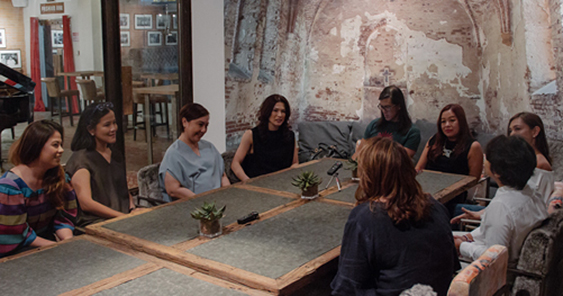We sit down with Philippine creative women leaders discuss what it is take charge and lead the charge in Asia-Pacific’s best place for women
Attendees:
- Madonna Tarrayo, president and Group COO of Straight Shooters/Unitel
- Merlee Jayme, chairmom and CCO of Dentsu Jayme Syfu
- Isa Lorenzo, founder and gallery director of Silverlens Projects Inc.
- Bebot Ngo, CEO at Publicis JimenezBasic Advertising
- Gina Lorenzana, vice president for personal care at Unilever Philippines
- Margot Torres, senior vice president for marketing of McDonald’s Philippines
- Liza Dino, chairwoman of the Film Development Council of the Philippines
- Angel Guerrero, EIC of adobo magazine
ACCORDING TO THE WORLD ECONOMIC FORUM’S GLOBAL GENDER GAP STUDY, THE PHILIPPINES IS THE BEST PLACE IN ALL OF ASIA AND THE 7TH BEST PLACE GLOBALLY FOR WOMEN. IS THERE A GENDER GAP IN THE PHILIPPINES?
Madonna: I think we’re a matriarchal country. Merlee and I were talking about it. I grew up in a family where the women are very strong and most of the time, the women had the last say. So it’s a very balanced world, growing up. I feel that should be true for a lot of us.
Merlee: My experience, even in advertising here, men bow down to the women. In the creative industry especially, when the women starts talking, they say, “Okay.” They give in, which I don’t see in other parts of the world. When we talk there, it seem like we like to hear our voices, you know? Here when we talk, we are respected. So to your question, I think, it’s not that big for me.
Margot: We have a Women’s Leadership Network in McDonalds. And my boss, who’s male, said, “I think I’m going to put a Men’s Leadership Network in the Philippines.” Because if you look at the number of women, it really breaks all the norms and I think because it’s a service industry, you really need to have attention to detail. And I don’t mean this as a criticism of men, but really females have better attention to detail.
Bebot: I think for us in our industry. It really feels like there’s not much gap because I think in our industry what we value is the ideas that these people bring to the table and normally, that’s gender neutral. But I don’t think women are all safe. There are a lot of things in society, in this country that needs to be fixed so that women are as safe as men.
Gina: Actually that gender balance for us, I think it’s skewed the other way, particularly in marketing and advertising. In fact, more women indeed and transgender people within that field. But I do believe that the gap exists in the senior most levels where I think there’s actually three things that we need to break. I think the first thing is equal opportunity for people to get to the top positions of most of the organizations. Secondly it’s the equal pay, but making sure that actually women receive the same salaries as men because, on average, women earn around 20% less than men. The third is about equal voice at the table. Even when women are actually in leadership positions, make sure that they’re heard just as equally as men around the table.
Madonna: In production, executive producers are mostly female because of details, budget management, and nurturing people. But when it comes to directors, for example, there are more male directors than women directors. There are very few female directors. So I think that’s where we can actually come in and break that gender gap, you know? Hiring more female directors, more female filmmakers, because I am sure they are just as competent as the male filmmakers. It’s just that the opportunity that needs to be given to them.
Liza: Well yeah, we still lack women directors, but we dominate the documentary section. Those documentary films we have a lot of women filmmakers.
Gina: There’s a book called the Athena Doctrine and it talks about the qualities of leadership in the future are what were traditionally seen as female qualities. Before, leaders were seen to be sort of dominant, sort of logical, sort of very left brained, which are traditionally sort of male qualities. And actually what they say, the leadership qualities of the future will be much more female qualities such a sympathy, empathy, understanding, and intuition.
Margot: In organizations, they already say now that culture trumps strategy. That organization health is the most fundamental companies to succeed. And it is the female traits, I think, that come forth so that you can really make that organizational health happen.
Liza: I had an interview with Ms. Charo Santos and she said: “It’s very typical for a chairman or a male to think twice whenever they take a risk. With women, she will stand by her decision.” Our intuition is a gift.
Gina: I want to build on what Margot was saying about culture. Because as women leaders, I feel like it’s something that we can contribute is to create a culture that changes the paradigm of working and leading. So that younger women leaders don’t have to navigate that sort of the same territory that we used to in our age.
Bebot: The more women there are in leadership, the more women will be there in leadership.
Isa: In my industry, when I started it, there was nothing there. So I sort of had a freehand in building a structure that was professional, that was organized, that was based on transparency, fairness, and partnerships. We did simple things that none of the art dealers were doing before. And incidentally, most of the Filipino art dealers were women. But we had to break the system by showing there are other ways of doing things. With regards to the gender gap, there is definitely a gender gap within the art world. I think men still command higher prices and it’s because they also fall faster because they are more risky. When I started Silverlens back in 2004, I realized that the spaces were half the size of this room. The shows ran for two weeks, if nothing is sold within those weeks they will change it. Artists are showing in five, six different galleries. And clients also knew that they could go directly to the artists. So I needed to get rid of all that and it took five years to convince the artist, the clients, that there’s a more professional way and that this is the only way we can get out to the world and become shoulder to shoulder with everybody else. Then eventually, everybody copied me.
WHAT HAVE YOU DONE TO MENTOR THE NEXT GENERATION OF WOMEN LEADERS?
Madonna: I teach in Benilde production management and I treat everybody the same. Whether you’re a boy or a girl, you have the same set of deliverables.
Bebot: I agree because I would not be able to answer that if that question is framed as only women. In Publicis we track the percentage of the males. We would just hire based on the person’s capability to contribute, potential, or current performance. Now personal mentoring, it depends on the job. It’s getting the opportunity and getting the right people for the job.
Madonna: Let’s admit it. It’s exhausting! It’s a matter of thinking, “This is the job. Who would be good for it? Who will help this person? Who is the catalyst to make all of that.”
Merlee: I got to this project in Cannes, encouraging women, because there’s a lack of women creatives worldwide. I’m guilty because I look at my creative department and everybody’s a man. I start interviewing the young women, they don’t want to move up. They want to get out. They cannot reconcile achieving a dream, having a family, having kids, and a husband in the hours we put in as a creative. Because as a creative you devote practically 24/7 to thinking of ideas. It doesn’t stop. My husband at home, he’ll say, “Your mind is somewhere else.” He could tell if my mind is thinking of a campaign. It’s a nonstop job and it’s difficult to keep it together, so these young women would rather not pursue it than fail in it.
You can achieve what you want and achieve your home life, for example. I got pregnant four times, so count how many maternity leaves I got. I probably started late on getting a very high position. I can park and come back. This is what I told them, “Nobody is telling you that you have to be be VP Creative Director at this age. As women, we are so organized that we have this mapped out, we have to be this by 45 and be that by 50. But you don’t have to sweat it. Like me, I gave birth four times. I tell my accounts person to wait three months. “Can it still be with me, when I get back?” I ask about the brief. At 40, that was the first time I got into, “I want to have my own agency and play my own rules.”








